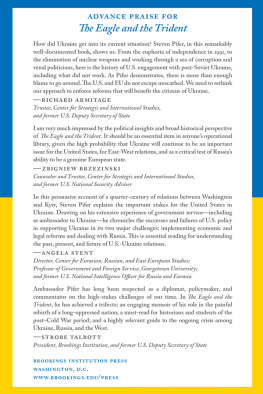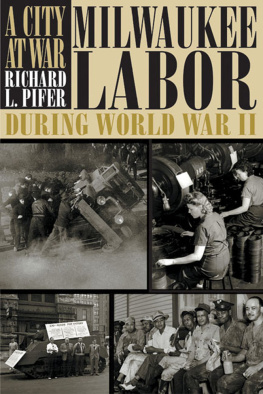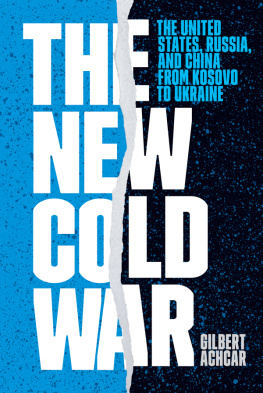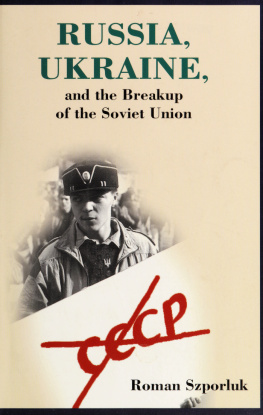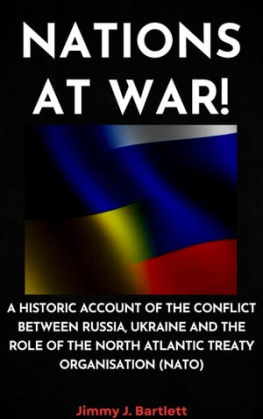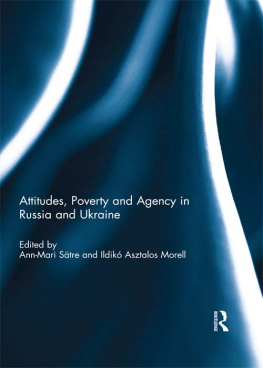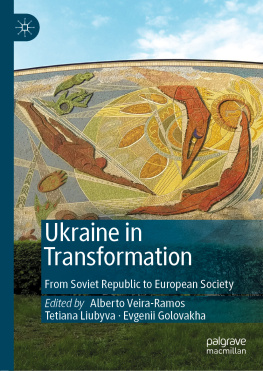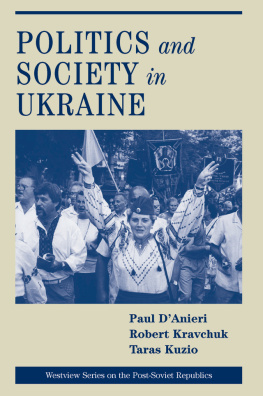The
EAGLE
and the
TRIDENT
U.S.-Ukraine Relations in Turbulent Times
STEVEN PIFER
BROOKINGS INSTITUTION PRESS
Washington, D.C.
Copyright 2017
THE BROOKINGS INSTITUTION
1775 Massachusetts Avenue, N.W., Washington, D.C. 20036
www.brookings.edu
All rights reserved. No part of this publication may be reproduced or transmitted in any form or by any means without permission in writing from the Brookings Institution Press.
The Brookings Institution is a private nonprofit organization devoted to research, education, and publication on important issues of domestic and foreign policy. Its principal purpose is to bring the highest quality independent research and analysis to bear on current and emerging policy problems. Interpretations or conclusions in Brookings publications should be understood to be solely those of the authors.
Library of Congress Cataloging-in-Publication data are available.
ISBN 978-0-8157-3040-8 (cloth : alk. paper)
ISBN 978-0-8157-3062-0 (ebook)
9 8 7 6 5 4 3 2 1
Typeset in Sabon
Composition by Westchester Publishing Services
Contents
Introduction
T he collapse of the Soviet Union was a seminal event in the late twentieth century. While hardly the great catastrophe bemoaned by Vladimir Putincertainly not in the eyes of subject peoples who gained the opportunity to shape their own nations and destiniesit dramatically altered the geopolitical landscape of Europe and Asia. Fifteen states emerged from the territory that mapmakers formerly called the Soviet Union.
The collapse was especially remarkable in two aspects. First, the rapidity of the end. In the mid-1980s, the Soviet Union stood as one of two global superpowers. Approaching the fifth decade of the Cold War, it challenged the United States and the West politically, militarily, economically, and ideologically. By the end of 1991, it had ceased to exist. Second, the relatively quiet nature of the collapse. While some bloodshed occurred, mainly as long-suppressed ethnic tensions broke out, the end was far more peaceful than might have been expected. For the most part, Soviet structures simply evaporated.
The collapse saw Ukraine regain its independence from Russia as well as from the Soviet Union. Ukraine had been a part of the Russian Empire or Soviet Union since Ukraines Cossack leaders signed the Treaty of Pereyaslav in 1654, except for a brief period from 1918 to 1921, roughly between the collapse of Czarist Russia after the October Revolution in 1917 and the formal founding of the Union of Soviet Socialist Republics in late 1922. Ukrainians and Russians both claimed Kyivan Rusthe state that from 882 to 1240 A.D. occupied much of present-day Ukraineas central to their historical, religious, and cultural heritage.
Official Washington was slow to recognize the coming collapse and showed a significant degree of ambivalence about the Soviet Unions demise. However, it became clear to all in December 1991 that the Soviet Union and its leader, President Mikhail Gorbachev, had no future. The U.S. government then moved swiftly to establish relations with each of the twelve New Independent States, in addition to the Baltic nations of Lithuania, Latvia, and Estonia, whose incorporation into the Soviet Union the United States had never diplomatically accepted and whose independence Moscow had recognized the previous September.
Of the new states, Ukraine was bound to receive a great deal of attentionindeed, the most attention after Russia. With nearly 52 million people in 1991, it was the second most populous post-Soviet republic. The largest country entirely within borders of the European continent, it lay just to the east of the nations of Central Europe. Now freed of the Warsaw Pact, those states would soon begin to press to join the European Union and the North Atlantic Treaty Organization (NATO), which would mean that Ukraine would find itself bordering two key European institutions as well as share a lengthy border with Russia. How Ukraine developed would have a big impact on the U.S. goal, dating back to the George H. W. Bush administration, of building a Europe whole, free, and at peace. How Ukraine developed was also bound to have an impact on how Russia evolved in the postCold War and post-Soviet world.
Ukraine seemed well placed to prosper as an independent state and become one of the early post-Soviet success stories. It had a highly educated and talented workforce. Economically, it contained agricultural land with immense productive potential, including some 30 percent of the worlds black earthrich and productive agricultural land (whereas the black earth is a foot deep in Iowa, it is three to four feet deep in Ukraine). The country also had a good portion of the Soviet Unions industrial base, particularly in the high-tech, heavy-metal, aerospace, electronics, and chemical sectors. Many analysts saw interesting prospects for mutually beneficial trade and investment. Proximity to Central Europe was seen as an advantage, to the extent that reforms already moving forward in countries such as Poland might serve both as a model and as encouragement for Ukraine to set a reform path of its own.
These factors plus the existence at the end of 1991 of nearly 2,000 strategic nuclear weaponswarheads atop intercontinental ballistic missiles and warheads for air-launched cruise missileson its territory meant that Ukraine was bound to figure significantly in U.S. foreign and security policy calculations.
This book does not try to capture all that has happened in Ukraine since it regained its independence. That is a long and complex story. This book focuses instead on the U.S.-Ukraine relationship from 1991 to the end of 2004. Much of my career as a foreign service officer during those years dealt with Ukraine: as a deputy coordinator in the Office of the New Independent States at the Department of State from 1993 to 1994; director then senior director and special assistant to the president in the Directorate for Russia, Ukraine, and Eurasian Affairs at the National Security Council from 1995 to 1997; U.S. ambassador to Ukraine from 1998 to 2000; and deputy assistant secretary of state responsible for Russia and Ukraine from 2001 to 2004. With the generous assistance of the Department of State, the National Security Council, and the Clinton Presidential Library, I was able to draw on my contemporaneous notes and records from much of that period in writing this book. I should note that the content, opinions, and characterizations in this book are my own and do not necessarily represent official positions of the U.S. government.
After my retirement from government service in late 2004, I found what other American diplomats who have served in Kyiv have found: Ukraine gets in ones blood. I continued to follow developments there, first with the Center for Strategic & International Studies and, beginning in 2008, at the Brookings Institution. I have had the opportunity to visit Ukraine regularly, to engage with senior Ukrainian officials, and to consult on U.S. policy toward Ukraine with officials at the State Department, the Pentagon, and the White House. While I have tried to stay informed about what is happening in Ukraine and in U.S.-Ukraine relations, I have not had the front-row seat on U.S. policymaking that I enjoyed when in government. Hence my decision to focus on the . The latter describes the key developments in U.S.-Ukraine relations from 2005 to 2016 but offers much less detail than the chapters covering the previous thirteen years.
This book is not intended to be a memoir. It is a diplomatic history. Much can be learned from Washingtons experience in those thirteen years about how and why U.S. policies toward Ukraine succeeded, how and why they failed, and how the United States might do better in advancing its primary objective with Ukraine. That objective has stayed remarkably consistent for the past twenty-five years: to see the country develop as a stable, independent, democratic state, with a growing market economy and increasing links to the West. That is the kind of Ukraine that is best compatible with broader American interests.
Next page
